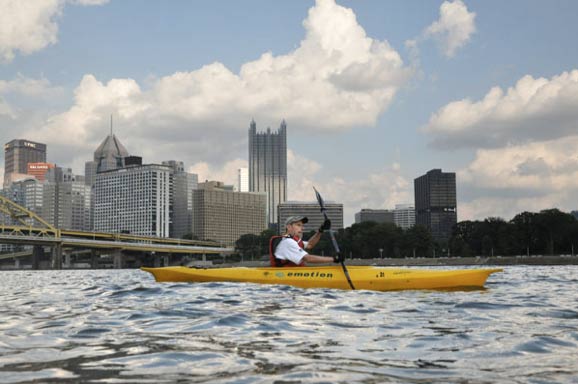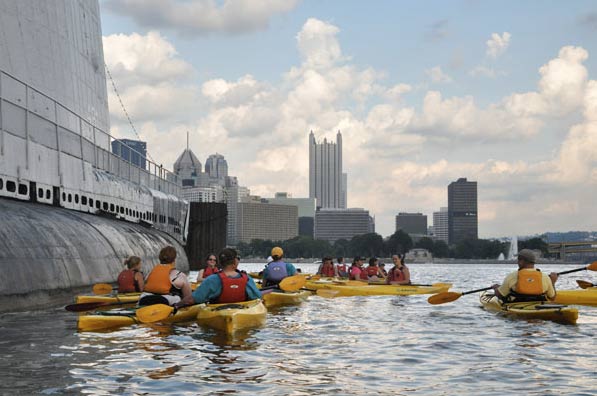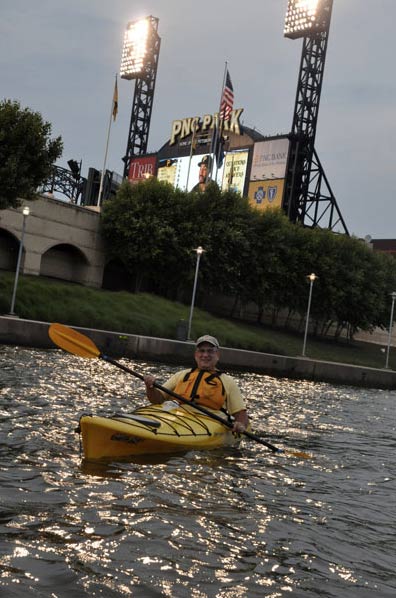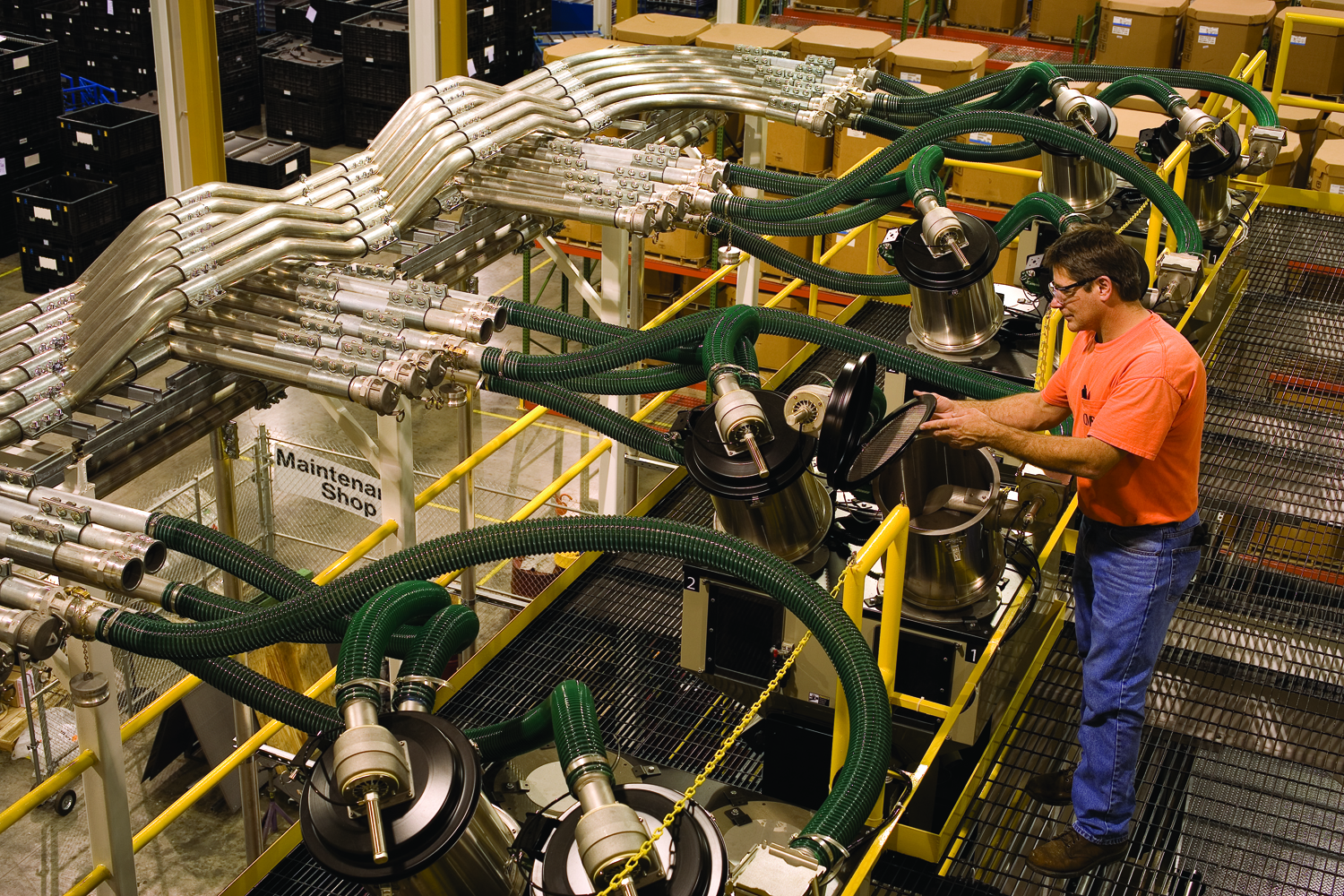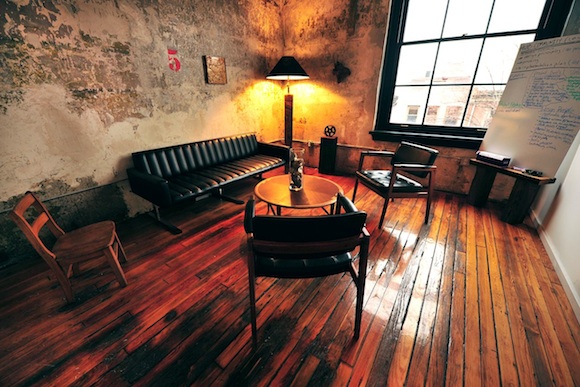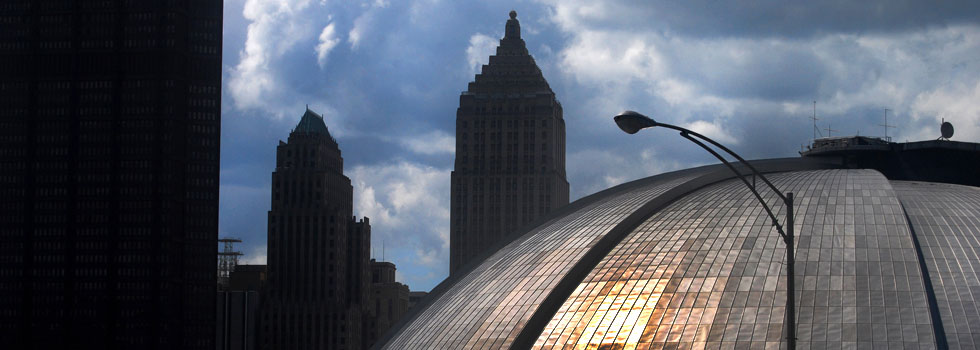This story originally published in sister publication Pop City.
I took up kayaking three summers ago after a health issue that landed me on the couch for several months. It felt important to reconnect with the physical world in a new way. And it was great. Nothing felt better than filling my lungs with fresh air, experiencing the cool tingle as the wind touched the water and surrendering to the repetitive motion of paddling.
Still, I wasn’t sure if I was going to continue kayaking when I moved from Connecticut to Pittsburgh. With the Long Island Sound at its border, Connecticut has a nautical culture. Pittsburgh was the City of Three Rivers, sure, but weren’t they mostly used for barges and postcard photos taken from Mt. Washington?
Last summer after buying my favorite model, the Tsunami 120, and exploring for a few months, I found the three rivers and neighboring areas have a lot to offer kayakers. I even decided to buy a trolling motor battery for kayak so that I could go a bit faster on the water. I love speed! Here’s my guide to making the most of it, for renters and owners alike.
Where do I rent?
A few years ago, the nonprofit Venture Outdoors established an excellent (and long overdue) program called Kayak Pittsburgh that launches rental boats from beneath the Roberto Clemente Bridge on the North Shore. From there, you can get a unique view of Pittsburgh’s most hulking, ironic sights: Heinz Field, PNC Park, Point State Park and the Carnegie Science Center. (Yes, you can paddle right alongside the submarine.)
Venture Outdoors also has outposts at the Milvale Boat Launch and on the boathouse on North Park Lake in McCandless Township. The latter is particularly useful for families with small kids getting into a boat for the first time.
As per the car-top rentals offered everywhere in Connecticut, the only place locally that I know to offer them is Wind and Water Boat Works in Butler.
What’s it like in our rivers these days? Aren’t they still dirty?
They’re a lot better than they used to be. But expect to see the occasional marooned barge overgrown with greenery (kinda urban cool) and graffiti-ed remains of concrete something-or-others here and there. It makes for an interesting ride.
Kayaking in the three rivers can be glorious. You get a view of America’s most awesome skyline that bests the one from Mount Washington. Pittsburgh’s bridges, particularly the McKees Rocks Bridge, look like wonders of engineering from the water. When you pull up beneath PNC Park during a Pirates Game, you see teeming city life teeming and it’s like you are accessing downtown the way you would from the canals of Venice. (Also, the rivers have these big metal and concrete cylinders, to which barges were once chained, and they are really fun to jump from.)
Once I rowed to the area beneath the 40th Street Bridge and saw some folks around a bonfire. A woman asked me, “Is it difficult kayaking this river?” I said, “It’s fine as long as you don’t mind some weird smells.” Her husband, a beer clenched in his fist and a gut protruding from his t-shirt, stood up and said, “Dude! She lives with me and all I do is make weird smells!”
Putting up with some weird smells is a small price to pay for someone or something you love.
What’s the best spot around to kayak?
As much as I love the Point, my vote goes to Harmarville. The area off its boat launch is truly a hidden gem. First, there is the odd sight of 12-Mile Island, a row of vacation homes accessible only by boat. It’s like a suburban cul de sac dropped into the Allegheny. There is the Allegheny Isle State Park, two islands left unblemished by development. And if you really want to cap off the trip, get past the dam by carrying the boat along the side of the river for a stretch. A mile or so from where you put in again is an island that is home to a 40-foot rope swing. I am eternally grateful to whoever risked his or her life to get it up there, because it is epic.
Do I need to register my kayak and get a sticker on the side?
The short answer: Don’t worry about that if you are going out on the Three Rivers.
In Pennsylvania, a canoe or kayak needs to be registered with the Fish and Boat Commission, and hence have an annual sticker on it, if it is used in a state park or put in at a state boat launch.
No area of the Three Rivers is within the confines of a state park and almost all of the launches around here are municipal, not state-owned. (The nearest state launch is on the Ohio in Beaver.)
If you were to take a kayak onto a body of water that is within or abuts a state park (like Lake Arthur in Moraine State Park or Lake Erie via Presque Isle), you are required to have some kind of documentation but an annual permit might not be the cheapest option if you only go up once or twice a year. Check with the Park Ranger’s office and ask if a day’s launch or mooring permit is available.
Do I need to put in at a boat launch?
Boat launches are a convenience but not a necessity for kayakers. They provide waterside parking and an easy path to the river, but a kayak can go any shore you can carry it to. (Try not to drag; that weakens the bottom, increasing the chances of a crack or hole.)
To access the Allegheny, the best, easiest are launches are in Milvale, Sharpsburg and Harmarville. For the Monongahela, try the one on the South Side, and for the Ohio, there is a launch in Glenfield. A complete map is here.
If you are confident in your ability to maneuver a slope while carrying a kayak, I recommend the park beneath the 40th Street Bridge in Lawrenceville and if you think you can handle a set of concrete stairs leading to the shore, there is the Riverview Memorial Park in Verona.
What gear do I need?
Three items are required: paddle, lifejacket and whistle. If there is even a chance you will be out after sunset, you will need two lights, one for the stern and one for the bow (though nighttime kayaking is probably not for beginners). Having lost a cell phone and two MP3 players out there, I would recommend a dry bag for anything valuable. Also given the coarseness or the places where you will put your feet and the occasional lack of visibility before you put them there, a pair of water shoes is a great investment.
Where do I buy gear?
Most sporting goods stores, including chains like Dick’s and L.L. Bean, have a supply of kayaks and gear. For the first-time kayak buyer I strongly recommend a smaller shop that specializes in kayaks and hence will have a staff that can answer any questions.) Exkursion Outfitters in Monroeville employs some of the most knowledgeable kayakers I have ever encountered, and they often hold classes at Keystone State Park and elsewhere.
What do I need to put a kayak on the top of my car?
Companies like Thule make roof racks for kayaks starting around $150 to adapt a bike rack and $400 for the full setup. While those are godsends for anyone taking a kayak on a long road trip, a set of foam blocks and strips will work just fine for taking a boat around locally. Dick’s and L.L. Bean sell everything-you-need packets for about $30. I personally stay off the highways and try not to go over 45 miles an hours when I have a kayak strapped to the car.
What would other kayakers say are the best places to kayak?
Let’s ask a few:
Noah Heck, co-founder, Kayak Anglers of Western PA:
“Western PA has a great deal to offer for kayakers, especially those who fish out of them. If we’re staying close to the city I really do enjoy fishing the Pittsburgh pool, the area from the city to the first lock/dam on each river, because I find it incredible to catch fish in such an urban setting. I also enjoy accessing areas larger boats can’t, because those spots usually hold the most fish!”
Jesse Twichell, kayak instructor with Exkursion Outfitters:
“Hands down, my favorite paddling destination in Western PA is Presque Isle on Lake Erie. It has unique natural beauty, fascinating history and several options for day trips. The peninsula’s interconnecting ponds offer a quiet place to observe wildlife, the bay bustles with activity, and the open water of the lake provides wind, waves, and long vistas. It’s a welcome challenge for those with the right equipment and skills.”
David Rohm, co-executive director, Paddle Without Pollution:
“There is the stillness on a cool fall morning paddling silently through the back channels and over-hanging cliffs at Lake Arthur and the diversity of Presque isle. Or the winding waters of 10 Mile Creek near Marianna…and its inner core of lush green beauty including many brilliantly colored species of wildflowers, and clear waters that have carved their way through towering ancient boulders. A spectacular little-known paddle.”
